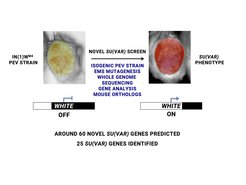Novel SU(VAR) factors and signaling to heterochromatin
Genetic screens for suppressors of position effect variegation (PEV) in Drosophila have been instrumental to identify crucial chromatin regulators that dictate heterochromatin formation. The laboratory of Gunter Reuter (University of Halle/Wittenberg) has pioneered the isolation and characterization of PEV modifier genes, such as, for example, Su(var)3-7 (encoding a Zn-finger protein), Su(var)3-9 (enabling the discovery of the mammalian Suv39h enzymes as the first KMT), Su(var)3-3 (encoding a H3K4 histone demethylase), Su(var)2-1 (a HDAC recruiter) (Walther et al. 2020) and several other important Su(var) genes.

While to date around 25 Su(var) genes have been molecularly defined, genetic analyses in Drosophila predict the presence of around 60 novel Su(var) loci (Figure 1). Conserved SU(VAR) factors between Drosophila and mouse will be selected for functional analyses in heterochromatin formation and repeat-dependent gene silencing. Intriguingly, several out of the novel Su(var) genes in Drosophila encode components for Ecdyson signaling and suggest that heterochromatin formation is not only developmentally regulated but could respond to hormone signaling. We treated mouse ES cells and differentiated MEFs with a variety of steroid-related compounds and found that Genistein (a plant phytoestrogen) can massively derepress MSR transcription in MEFs.
This example highlights the significant insight that can be gained by the functional analysis of novel SU(VAR) factors and reveals that MSR derived heterochromatin is particularly sensitive to stress signaling pathways.
